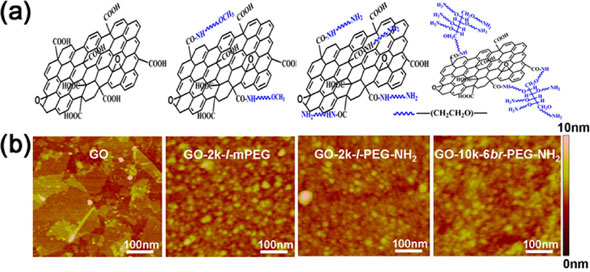| Posted: Jun 07, 2012 | |
Modulating enzyme activity with functionalized graphene oxide |
|
| (Nanowerk Spotlight) One area of nanobiotechnology is concerned with designing and engineering suitable nanomaterials for biological applications. Although nanobiology researchers have frequently reported various effects of nanomaterials on biomolecules, cells, tissues, and animals, the mechanisms behind these effects have rarely been explored – despite the fact that an understanding of interactions between nanomaterials and biomolecules is of fundamental importance for this field. | |
| One type of biomolecules, enzymes, regulate almost all chemical reactions involved in numerous biological processes in living organisms and are also widely used in research and industry – pharmaceutical and medical, food and environmental, biofuels and life sciences. | |
| "Regulation of enzyme activity and stability is very important and has always attracted great attention" Rui Peng, an associate professor in the Institute of Functional Nano & Soft Materials at Soochow University in Suzhou, PR China, tells Nanowerk. "Various enzyme regulators, ranging from proteins, peptides, and synthetic organic molecules, have been discovered. Recently, nanomaterials evolve as promising alternatives for enzyme modulation. Nanomaterials provide large surface areas for biomolecule adsorption and can be engineered to present multiple surface functional groups for interacting with biomolecules, such as enzymes and/or their substrates." | |
| In a recent study, Peng together with her collaborator Zhuang Liu, a professor of chemistry, and their teams, started to explore the interactions between functionalized graphene oxide and serine proteases, a large family of enzymes with important biomedical and industrial applications. They reported their findings the May 10, 2012 online edition of ACS Nano ("Functionalized Graphene Oxide in Enzyme Engineering: A Selective Modulator for Enzyme Activity and Thermostability"). | |
| The researchers point out that, to their best knowledge, this work is the first to successfully report the use of functionalized graphene oxide as an enzyme modulator with positive effects; high efficiency; and great selectivity for both the enzyme (trypsin) and the substrate (phosphorylated proteins). | |
| "More importantly, we extended our investigation to explore the mechanism behind the modulation, and identified two involving factors which led us to a hypothesis of possible functions of PEGylated graphene oxide (GO-PEG) in the digestion reaction," says Peng. "Although further work is required, our work highlights that the interactions of nanomaterials with biomacromolecules, in general, can be regulated through and are closely associated with their surface chemistry and/or nanointerfaces." | |
| Many nanomaterials, before surface modification – i.e. functionalization – possess rather hydrophobic surfaces, resulting in poor dispersibility in water and physiological solutions, as well as poor biocompatibility. For example, as shown in the Chinese team's work, the unfunctionalized graphene oxide dramatically inhibits enzyme activity, likely due to the nonspecific binding of enzyme proteins on graphene oxide via hydrophobic interactions, resulting in possible blocking or denaturing of the enzyme active center. | |
| Researchers use functionalization to improve biocompatibility of these nanomaterials and, while doing so, alter their surface chemistry. | |
| "This could potentially alter the way they interact with other materials and/or biomolecules, leading to newly developed functions – our GO-PEGs with different PEGylations just proved that" says Peng. | |
 |
|
| Graphene oxide nanosheets used in the study: schemes (a), AFM images (b), and dispersibility in water and PBS. (Reprinted with permission from American Chemical Society) | |
| In their work, the team investigated the effects of two types of PEGylated GO nanosheets with free amines on three important serine proteases: trypsin, chymotrypsin, and proteinase K. Both nanosheets significantly improved trypsin activity and thermostability, while showing barely any effect on chymotrypsin or proteinase K. | |
| Peng points out that either blocking the functional amino groups or replacing the two-dimensional graphene oxide with one-dimensional single-walled carbon nanotubes abolished the stimulatory effect, suggesting the involvement of both the terminal amines on polymer coatings and the unique 2-D structure of graphene oxide. | |
| "Detailed enzyme kinetics analysis revealed that PEGylated GO functions at both the initiation step and later steps along the reaction process," says Peng. "We also found that at least up to 43-fold of reaction acceleration induced by PEGylated GO could be achieved depending on the substrate concentration." | |
| Going forward, the biggest challenge for the scientists is that so far they cannot control the synthesis and surface modification of these nanomaterials as precisely as they do with proteins (through gene/protein engineering); something which might cause a certain level of uncertainty and difficulty when interpreting the results. | |
| "Therefore, from the materials side, better control in surface chemistry, size, and morphology of nanomaterials is critical," say Peng and Liu. | |
 By
Michael
Berger
– Michael is author of three books by the Royal Society of Chemistry:
Nano-Society: Pushing the Boundaries of Technology,
Nanotechnology: The Future is Tiny, and
Nanoengineering: The Skills and Tools Making Technology Invisible
Copyright ©
Nanowerk LLC
By
Michael
Berger
– Michael is author of three books by the Royal Society of Chemistry:
Nano-Society: Pushing the Boundaries of Technology,
Nanotechnology: The Future is Tiny, and
Nanoengineering: The Skills and Tools Making Technology Invisible
Copyright ©
Nanowerk LLC
|
|
|
Become a Spotlight guest author! Join our large and growing group of guest contributors. Have you just published a scientific paper or have other exciting developments to share with the nanotechnology community? Here is how to publish on nanowerk.com. |
|
